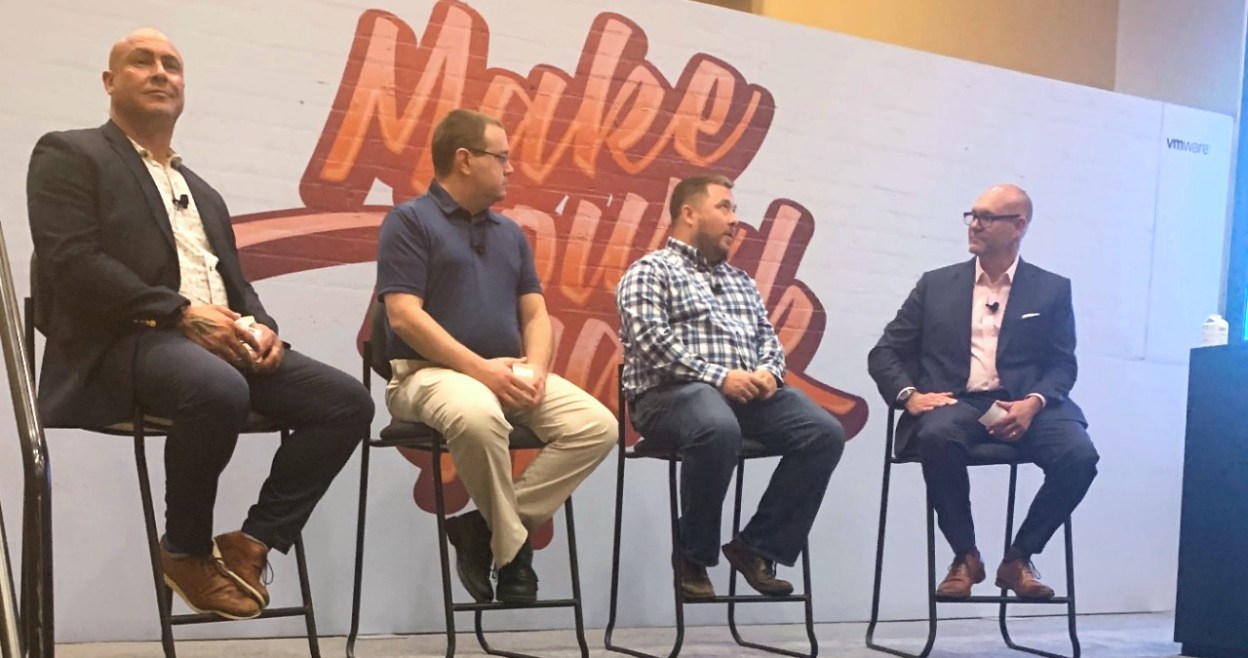What is hyperconverged infrastructure (HCI), and is the promise of HCI all it’s cracked up to be? A panel of HCI experts explain everything you need to know about this foundational technology for the cloud era.
Meet the HCI Experts

Lester Shisler is senior IT systems engineer for Harmony Healthcare IT. The Indiana-based IT analyst firm specializes in data management and archival. They help healthcare organizations preserve information when moving from legacy electronic health record (HER) systems to updated technologies. Business is good, Shisler says, which means there’s a lot of data to move and store. That’s where the scalability of HCI comes in.

Matthew Douglas is chief enterprise architect for Sentara Healthcare, a not-for-profit healthcare organization headquartered in Virginia. IT at Sentara must quickly adapt to the changing healthcare industry, while ensuring critical technologies are always available. HCI is IT’s ticket to greater agility and performance, says Douglas.
Why Hyperconverged Infrastructure?
HCI combines virtualized storage, compute and networking into a single system. HCI enables businesses to replace expensive hardware, decreasing complexity and increasing scalability. Here’s what the experts say.
HCI helps IT quickly and cost-effectively respond to change.
Harmony Healthcare IT must be ready to move up to billions of unique data from an organization’s customized legacy system. As the business grows, IT needs to quickly make room to store new customer data. “In 12 months, our data requirements have more than quadrupled, and it’s all customer-driven,” says Shisler. With HCI, IT easily scales, while offering competitive costs for customers. “It was a pretty massive savings for us with the performance we needed,” he says. “The company I work for would look a lot different if we didn’t have something like this.”
HCI grants IT greater agility and performance.
Sentara previously managed “a giant, massive amount of servers that we couldn’t manage centrally,” Douglas says. The move to HCI saved the company millions after one year. It also helped keep the user experience consistent and downtime to a minimum. “Our business is keeping people live. People die every day in healthcare organizations because of failed systems, miscommunication of records, all of these different scenarios,” he says. “Since going to hyperconverged infrastructure, we’ve had no outages. Prior to that, we had outages, and outages cost people’s lives. When doctors are entering data and operating on people, if that information’s not available, people make on-the-spot decisions. And that’s just not right in today’s world with technology.”
What Matters in a Hyperconverged Solution?
Familiarity, consistency and compatibility go a long way for these HCI experts.
A Familiar Interface
Shisler and his team chose an HCI solution from a technology provider that the company and most of its customers already use for virtualized computing. The VMware HCI interface combines the management experience of VMware computing and storage solutions. That means it’s familiar and easier for Shisler’s team to get up to speed on the new solution. “We were already using VMware for our base product, and the vast majority of the deliverables that our customers request is in VMware vSphere,” Shisler says. “This is stuff we already knew.”
A Single Platform
For Douglas, his perfect HCI solution is a consistent, integrated platform. “VMware was a consistent, single platform for hyperconvergence,” he says. “Plus, there’s VMware NSX, there’s all these things that fit together in a nice, uniform fashion. And as an enterprise, I couldn’t make a choice of more independent software and all these other different tools. One consistent tool is truly the only choice for the enterprise.”
Before, IT wasn’t a first thought. Now, IT is a business driver and business decision-maker. They’re actually coming to IT first and saying, 'Hey, what do you think about this?' About machine learning, PACS and image diagnosis of cancer.
Matthew Douglas, Chief Enterprise Architect, Sentara Healthcare
How Does Hyperconverged Infrastructure Impact IT?
IT is organized around the technology it operates. As technology like storage and computing evolves, so does IT.
- Silos Break Down: With HCI, the hyperconvergence of compute, storage and networking happens not only on a technological level but also on an organizational level. It didn’t surprise Douglas to see silos break down between the storage and compute teams at Sentara or to see system admins work with developers. He was, however, “surprised it was so quick,” he says.
- DevOps Becomes Possible: “Having vSAN onsite gives developers the ability to test and spin up development systems to move towards a DevOps structure, and we’ve become involved in that,” Shisler says. “Development used to be this far off thing, and they wanted these things that are unrealistic. It’s evolved into more of a working relationship with them.”
- IT Gains Visibility: With modern infrastructure, IT enhances their abilities to deliver IT services to the business, building visibility and trust. “Before, IT wasn’t a first thought. Now, IT is a business driver and business decision-maker,” Douglas says. “They’re actually coming to IT first and saying, ‘Hey, what do you think about this?’ About machine learning, PACS [picture archiving and communication system] and image diagnosis of cancer.”
- Employers Take Notice: Initially somewhat resistant to change, Sentara IT workers eventually embraced new opportunities to collectively drive digital transformation. “Because once they put that on their resume, they’re rock stars,” according to Douglas, who says he got nearly 30 job offers after he first successfully executed HCI in a previous role.
What Are the Benefits of Hyperconverged Infrastructure to Cloud Strategies?
HCI is known as a building block for hybrid cloud. By virtualizing and centralizing core elements of the data center, IT can easily connect workloads to cloud infrastructures.
Early Cloud Strategies
Given the need to scale at Harmony Healthcare IT, “There is some future for our company, I believe, in the cloud,” Shisler says. Whether it’s all in the cloud or a hybrid cloud, HCI puts them a step closer to that future state.
Pioneering Cloud Strategies
Sentara has operated in the cloud for some time. Now, Douglas applies his experience with modern HCI architectures and cloud to help progress the entire healthcare industry. “Healthcare is a very slow adopter to cloud or hyperconvergence,” Douglas says.

